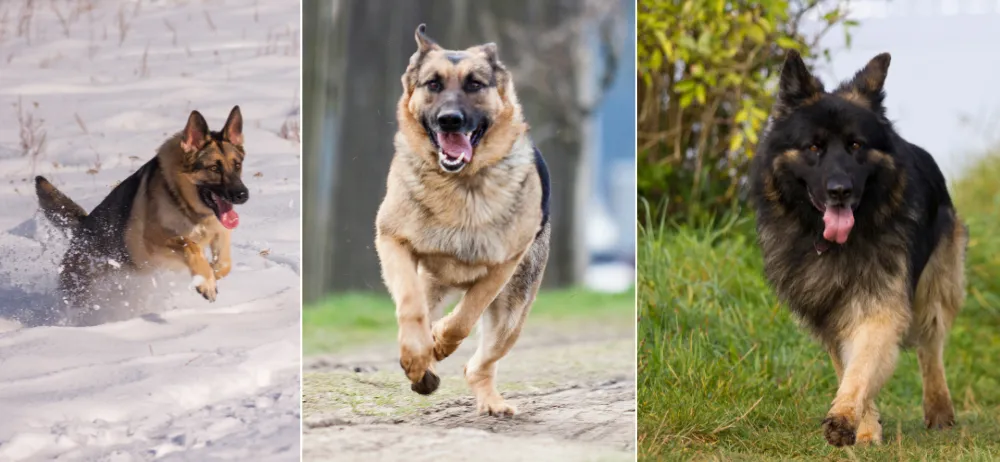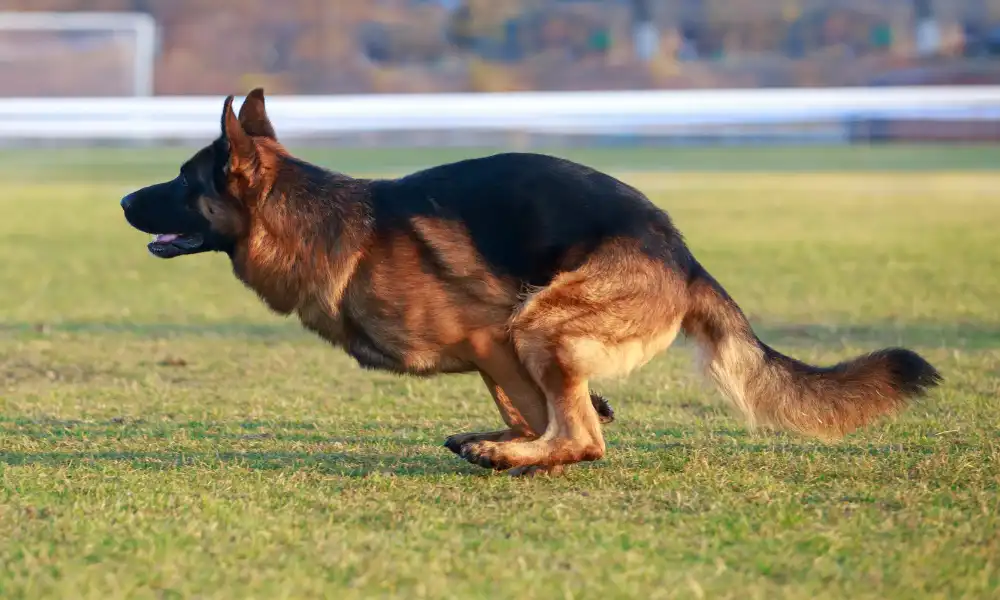Would you like to know about the average running speed and distance of a German Shepherd, and its longest known runs in a single session? You’re in the right place.
German Shepherds (GSDs) are renowned for their athleticism, agility, and stamina. Their physical abilities make them one of the most versatile dog breeds, excelling in roles ranging from herding to search-and-rescue missions.
| Do you know? The Greyhound is the fastest dog breed, reaching speeds up to 45 mph (72 km/h). They excel in short-distance sprints due to their aerodynamic build and powerful legs. |
In this article, we explore the average running speed and distance of a German Shepherd, as well as the breed’s extraordinary endurance abilities.
Topics
- Average Running Speed of a German Shepherd
- Average Running Distance
- Exceptional Endurance: The Longest Known Runs
- Factors Influencing Running Performance
- How to Help German Shepherds Run Faster
- Precautions When Running with a German Shepherd
- Conclusion
RELATED
- Understanding the Prey Drive of German Shepherds
- How to Extend the Lifespan of German Shepherd
- German Shepherd Energy Levels by Age | Activity Needs
- Best Way to Take German Shepherd for Walk: A Complete Guide
- Regular or Retractable Leash! Best for German Shepherds?
- How Do German Shepherds Handle Hot Weather
|| DON’T MISS! Today’s Deals on Chewy – Pet Foods, Products, Supplies, Toys and more…
01. Average Running Speed of a German Shepherd
A healthy adult German Shepherd can reach speeds of up to 30 miles per hour (48 km/h) in short bursts.
This remarkable speed is largely due to their powerful, muscular build and efficient stride. While 30 mph is their maximum sprinting speed, they typically maintain a slower pace for sustained periods, depending on their fitness level and conditioning.
| Sprinting Speed is the maximum velocity a person or animal can achieve during a short, intense burst of running. It is typically measured in meters per second (m/s) or miles per hour (mph). |

German Shepherds rank around 10th to 11th among the fastest dog breeds, with a top speed of 30 mph (48 km/h).
Here’s a table of the top 15 fastest dog breeds, their speeds, and key traits:
| Rank | Dog Breed | Speed (mph) | Speed (km/h) | Notable Traits |
|---|---|---|---|---|
| 1 | Greyhound | 45 mph | 72 km/h | Slim, muscular build; ideal for sprinting. |
| 2 | Saluki | 42 mph | 67 km/h | Known for endurance and speed over long distances. |
| 3 | Afghan Hound | 40 mph | 64 km/h | Elegant and strong, built for agility and speed. |
| 4 | Vizsla | 40 mph | 64 km/h | Energetic, with excellent stamina and speed. |
| 5 | Jack Russell Terrier | 38 mph | 61 km/h | Small but incredibly quick and agile. |
| 6 | Dalmatian | 37 mph | 59 km/h | Known for their endurance and sleek build. |
| 7 | Borzoi | 36 mph | 58 km/h | Graceful and fast, bred for hunting in open fields. |
| 8 | Whippet | 35 mph | 56 km/h | Smaller cousin of the Greyhound, excellent sprinter. |
| 9 | Doberman Pinscher | 32 mph | 51 km/h | Strong and agile, with impressive speed and focus. |
| 10 | Border Collie | 30 mph | 48 km/h | Highly energetic and skilled in herding tasks. |
| 11 | German Shepherd | 30 mph | 48 km/h | Strong, versatile, and fast over short distances. |
| 12 | Siberian Husky | 28 mph | 45 km/h | Bred for endurance and speed in cold climates. |
| 13 | Belgian Malinois | 28 mph | 45 km/h | Agile and quick, often used in police work. |
| 14 | Scottish Deerhound | 28 mph | 45 km/h | Tall and athletic, with a strong sprinting ability. |
| 15 | Poodle (Standard) | 30 mph | 48 km/h | Surprisingly fast, with intelligence and agility. |
02. Average Running Distance
When it comes to running distances, German Shepherds are equally impressive. On average, they can run between 5 and 10 miles (8 to 16 km) at a moderate pace, provided they are in good health and have undergone proper training.
Regular exercise and conditioning play a significant role in determining how far a German Shepherd can run without becoming fatigued.

03. Exceptional Endurance: The Longest Known Runs
German Shepherds are bred for endurance, and some individuals have been known to exceed their typical running limits. In optimal conditions and with adequate training, a German Shepherd can run up to 20 miles (32 km) in a single session. However, it’s important to note that such feats require careful preparation to avoid overexertion or injury.
In extraordinary cases, German Shepherds have demonstrated even greater stamina. For example, during endurance trials or herding competitions, these dogs have been reported to cover distances of up to 50 miles (80 km) over the course of a day.

04. Factors Influencing Running Performance
Several factors influence a German Shepherd’s running speed and distance:
- Young adult German Shepherds (2-5 years old) at their peak physical condition perform very well. Young puppies and senior dogs may not perform very well.
- Dogs with good overall health and regular exercise routines can achieve greater speed and endurance.
- Proper nutrition and hydration are crucial for maintaining energy levels and avoiding fatigue during long runs.
- Extreme heat or cold can negatively affect a dog’s ability to run long distances.
- Gradual conditioning improves a dog’s cardiovascular health and muscle strength, enabling longer and faster runs.

05. How to Help German Shepherds Run Faster
To train and help German Shepherds run faster, focus on building their strength, endurance, and agility:
- Sprint Intervals: Practice short bursts of high-speed running with rest in between to improve speed and stamina.
- Hill Runs: Running uphill builds leg strength and power.
- Agility Drills: Use weave poles, jumps, or obstacle courses to enhance coordination and quick movements.
- Strength Training: Incorporate tug-of-war and weight-pulling exercises such as dragging a sled, weighted harness walks, or pulling resistance carts on soft ground to strengthen their muscles. Start with light weights, gradually increase resistance, and ensure proper equipment to prevent strain or injury.
- Endurance Runs: Gradually increase the distance of runs to improve overall stamina and cardiovascular health.
| Cardiovascular health refers to the fitness of the heart and blood vessels, enabling efficient blood circulation. Regular exercise, a balanced diet, and maintaining a healthy weight are key to supporting cardiovascular function. |

06. Precautions When Running with a German Shepherd
While German Shepherds are naturally athletic, they are not immune to the risks associated with overexertion.
| Overexertion occurs when the body is pushed beyond its physical limits, leading to fatigue, stress, or injury. |
Here are some essential tips to ensure safe running sessions:
- Start Slowly: Gradually increase the intensity and distance of runs to build endurance.
- Watch for Signs of Fatigue: Excessive panting, lagging behind, or limping are signs that your dog needs rest.
- Provide Water Breaks: Always have water available during long runs, especially in warm weather.
- Check Their Paws: Regularly inspect your dog’s paw pads for cuts or abrasions after running on rough surfaces.
- Consult a Veterinarian: Before embarking on a rigorous running program, ensure your dog is fit and healthy.

06. Conclusion
The German Shepherd is an extraordinary breed capable of impressive running speeds and distances. With proper care, training, and conditioning, they can become exceptional running companions, excelling in both speed and endurance. Whether sprinting at 30 mph or covering miles in a day, their physical capabilities are a testament to their remarkable athleticism and versatility.
If you like this post then don’t forget to share with others. Share your feedback in the comments section below.
Also Read
- At What Age German Shepherds Slow Down?
- What are Challenges of Training & Raising German Shepherd?
- What is the Average Intelligence of German Shepherds?
- Ultimate Guide to German Shepherds Water Activities
- Breeding Frequency for Male German Shepherds




Leave a Reply